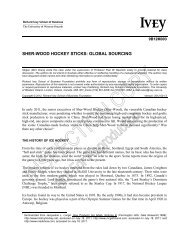foundation of canada asia pacific - Content Tagged with
foundation of canada asia pacific - Content Tagged with
foundation of canada asia pacific - Content Tagged with
Create successful ePaper yourself
Turn your PDF publications into a flip-book with our unique Google optimized e-Paper software.
○ ○ ○ ○ ○ ○ ○ ○ ○ ○ ○ ○ ○ ○ ○ ○ ○<br />
○ ○ ○ ○ ○ ○ ○ ○ ○ ○ ○ ○ ○ ○ ○ ○ ○<br />
○ ○ ○ ○ ○ ○ ○ ○ ○ ○ ○ ○ ○ ○ ○ ○ ○<br />
○ ○ ○ ○ ○ ○ ○ ○ ○ ○ ○ ○ ○ ○ ○ ○ ○<br />
○ ○ ○ ○ ○ ○ ○ ○ ○ ○ ○ ○ ○ ○ ○ ○ ○<br />
IMPORTS FROM ASIA PER CAPITA 1998 (C $)<br />
0 500 1,000 1,500 2,000 2,500<br />
Canada<br />
BC<br />
Ontario<br />
Quebec<br />
Newfoundland<br />
Manitoba<br />
Nova Scotia<br />
Alberta<br />
New Brunswick<br />
Saskatchewan<br />
PEI<br />
Yukon/NWT<br />
Sources: Adapted from Statistics Canada,<br />
Imports by Country, January to December 1998<br />
(Cat. No. 65-006, Vol. 55, no. 4).<br />
39<br />
a valuable demonstration effect on Canadian businesses thinking <strong>of</strong> investing in Asia, APFC<br />
has begun collecting M&A data as a long-term project and as a service to government<br />
and business.<br />
Canadian companies, along <strong>with</strong> investors from most developed countries, have recently<br />
taken advantage <strong>of</strong> depressed asset values and relaxed regulations to substantially increase<br />
their investment in existing Asian-based enterprises. According to a listing prepared by<br />
the Asia Pacific Foundation, 25 Canadian companies have invested US $2.5 billion in<br />
Asian purchases since July 1997. This compares <strong>with</strong> US $1 billion invested by 37 companies<br />
in the eleven-and-a-half years before the crisis. (In each period, several companies were<br />
involved in multiple deals, so the total number <strong>of</strong> transactions exceeds the number <strong>of</strong><br />
companies involved.) In addition, the average size <strong>of</strong> the deals has increased since 1994.<br />
There has been a notable shift in the focus <strong>of</strong> the takeovers as well. More than half the<br />
deals in the first period involved investments in mining activities — including a spate <strong>of</strong><br />
small acquisitions in Indonesia when the Bre-X gold fever was at its height. Since the<br />
Asian crisis, fewer than a quarter <strong>of</strong> transactions have been in the mining sector. This<br />
is significant as the motivation for <strong>of</strong>fshore investment by mining companies is to secure<br />
their raw materials. The desire to gain economies <strong>of</strong> scale by expanding operations may<br />
also exist, but it is generally secondary to the acquisition <strong>of</strong> an ore body. There may be<br />
some benefit to Canadian exports if mining equipment and supplies are involved in the<br />
project. However, mining investments do not hold out the same promise <strong>of</strong> long-term<br />
trade linkages back to Canada as do manufacturing investments. 13<br />
Renewed interest in Asian investment as the region recovers from the financial crisis is<br />
also suggested by a survey <strong>of</strong> investment intentions carried out by APFC late last year. 14<br />
The survey <strong>of</strong> companies that already have a physical presence in Asia Pacific, found<br />
that 56% planned to increase their investments in the region over the next 12 months,<br />
while 74% said they expected to boost their holdings <strong>with</strong>in two to five years. Only<br />
four out <strong>of</strong> the 68 respondents had decided to reduce their exposure in Asia. Just<br />
under 60% <strong>of</strong> the respondents were manufacturers or service suppliers targeting Asia-<br />
Pacific customers. Most <strong>of</strong> the companies planning increased investments were looking<br />
to add new facilities or add to existing plant. Only nine out <strong>of</strong> 56 expected to grow<br />
through takeovers <strong>of</strong> existing companies. This could be explained by the motivation



